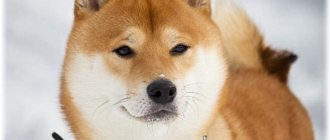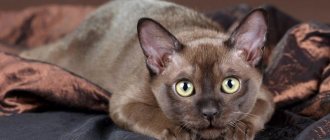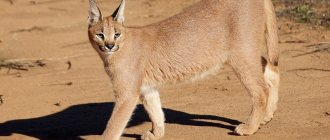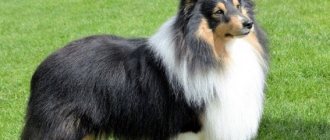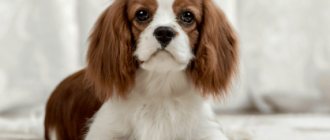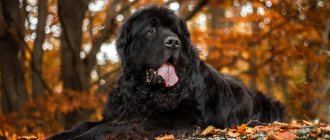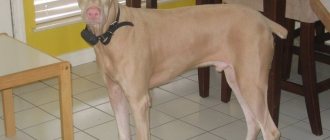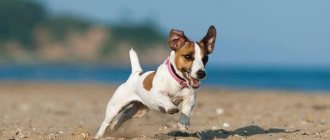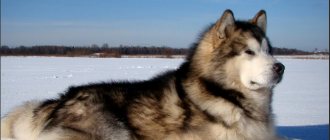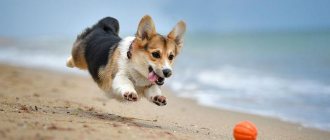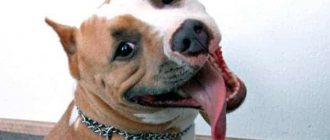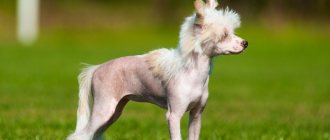History of the Newfoundland breed
Newfoundland
The homeland of the breed, which shares its name, is the island of Newfoundland, located off the east coast of North America and belonging to Canada. There are many legends about the origin of these dogs, and many of them, quite possibly, are not so far from the truth.
Some cynologists suggest that the ancestors of Newfoundlands are Berenbeitzers, bear-fighting dogs common in medieval Europe, which are also considered the ancestors of mastiffs. These powerful dogs allegedly arrived on the island with a Viking crew led by the Scandinavian navigator Leif Eriksson on a ship that arrived off the coast of Newfoundland around the year 1000. Subsequently, the descendants of these animals went wild. When Europeans appeared here again in the 16th century, they were amazed at the sight of the huge black and shaggy dogs they met here.
According to the famous Swiss cynologist, Professor Albert Heim, who specialized in the study of Newfoundlands, these animals descended from Molossians, massive mastiff-like dogs of the so-called mastiff type, brought to the island by the British during the period of its colonization.
There is an opinion that among the ancestors of Newfoundlands are large black and piebald shepherd dogs, which also came overseas from the European continent. White Pyrenean mountain dogs are also mentioned, which could have been brought to North America by Spanish and Portuguese settlers. It is believed that it was thanks to them that the black and white color of Newfoundlands arose.
Some dog experts suggest that the formation of the breed could not have happened without the aboriginal representatives of the dog tribe. Presumably, already in the 11th century, indigenous tribes lived on the island, descendants of the Paleo-Eskimo peoples, whose companions and assistants were sled dogs. Perhaps it was from them that Newfoundlands inherited their friendly disposition and determination to come to a person’s aid under any circumstances.
The first descriptions of dogs from the island of Newfoundland began to appear at the dawn of the 18th century. There were two known types: the "Little Dog of St. John" and the "Big Dog of St. John." “Saint John” or “St. John’s” is the name of the largest settlement on the island at that time, today it is the main city of the Canadian province of Newfoundland. The descriptions noted the excellent working qualities of these dogs, their good-natured character, as well as the ability to dive deep and swim far. The British began to export dogs from the island and soon began their systematic selection. The first type was used in the development of the retriever breed, and the second became known as the Newfoundland. According to some sources, for the first time, in 1775, George Cartwright named his dog a Newfoundland.
Newfoundland puppy
Initially, English breeders selected black and white dogs for breeding, later named Landseers in honor of the British painter Edwin Henry Landseer. He loved to depict such dogs on his canvases. However, over time, breeders began to give preference to animals with a solid black color.
In the middle of the 19th century, a fashion arose in Great Britain for large representatives of the dog breed. At exhibitions in 1860 and 1862, held in Birmingham, dogs from the island of Newfoundland made a splash, and in 1864, a dog belonging to the Prince of Wales himself took first place at the Birmingham Exhibition. In 1878, the first Newfoundland was entered into the stud book of the English Kennel Club, the oldest kennel club in the world, and a year later a breed standard was developed. The magnificent, powerful dogs began to rapidly gain popularity in Europe, and in 1885 the first Newfoundland fan club was founded in the USA. Today, in famous kennel clubs in Europe and the USA you can buy Newfoundland puppies, whose official pedigree dates back to the 80s of the last century.
At the beginning of the 20th century, Newfoundlands gained popularity among Russian aristocrats, but fashion for them did not become widespread. In the 40-50s, representatives of this breed were actively exported to the USSR from Germany. At the Ministry of Defense nursery “Red Star”, breeders worked to improve the working qualities of Newfoundlands. They were crossed with German and Caucasian shepherds, trying to give the dogs aggressiveness and at the same time preserve their rescuer instincts. These experiments ended in failure, since the dogs, instead of helping the person, showed aggression towards him. Newfoundlands also did not succeed in guard duty. In the 80s, breeding work to develop a new breed was stopped, although it managed to get its own name - Moscow diver.
Since the mid-80s, breeding of imported Newfoundlands began in Russia, and Moscow divers gradually “dissolved” in their population. Their memory is preserved by the pedigrees of a small number of domestic Newfoundlands and the tradition of calling this breed of dog divers. Newfoundlands are often also called Newfies.
Features and description
The Newfoundland dog is a great friend and companion. She has a natural intuition that allows her to accurately guess the mood of every person with whom she interacts. But the main feature of the breed is not good nature at all, but a well-developed rescue instinct.
This is one of the few dogs that can not only swim well, but also dive expertly. He does this in order to save a drowning man. A dog diving into the water smells a person in need of help. It is unique in that it has a so-called superior sense, which allows it to accurately determine the smell of a drowning living creature not only on land, but also in the aquatic environment.
Yes, the dog searches for a person drowning in water, relying not on sight, but on smell, that is, smell. When a person is found, the dog pulls him up, firmly grasping his neck with his teeth. At the same time, it does not cause injury. His grip is firm but not painful. When the drowning person is pulled to the surface, the animal will swim with him to the shore. His second name is diver.
Evidence that Newfoundlands love water dates back to the 18th century. In old sources, experts found information that these animals swim, dive well and have amazing endurance. It is impossible to say exactly how long such a dog must swim before getting tired.
Previously, fishermen often took the dog with them to help retrieve nets with their catch that were immersed deep in the reservoir. The animal's ability to dive was highly valued by them. When the dog took the net out of the water, he did not claim the fish. He has an inherent desire to help people selflessly.
The fame of representatives of this breed quickly spread throughout the world. They were wanted by rich and poor people, aristocrats and representatives of the proletariat class, adults and children, in general, all dog lovers.
The birthplace of the Newfoundland breed is one of the Canadian provinces. In the 19th century, dogs began to be actively exported to England, where local breeders were engaged in their further selection. The preferred color requirements have changed many times. In 1986, a diving club was first organized in England. But the breed gained its greatest popularity only in the 2000s.
Newfoundland appearance
Brown Newfoundland
The Newfoundland is a powerful, athletic dog whose coat resembles a luxurious boyar's fur coat. The huge size of the dog does not make it clumsy and clumsy. On the contrary, they have excellent control of their own body and look quite graceful. Males can weigh up to 70 kg, females - up to 55 kg.
Frame
The Newfoundland's body is strong, dense, and compact. The length of the body from the withers to the base of the tail is identical to the length from the withers to the floor. The back and croup are wide, solid, the loin is strong, muscular, the chest is powerful. The lower line of the chest and abdomen is almost flat. Bitches' bodies are often more elongated and not as massive as those of males.
Head
Large, heavy, with a wide skull with a slightly protruding arch. The occipital protuberance is well developed. The stop is discernible, but it is not overly sharp. The Newfoundland's relatively short muzzle is square in shape and covered with short, soft fur. There are no skin folds on the muzzle. The corners of the mouth are clearly expressed. Cheeks are soft. The nostrils are well developed. The color of the nose is distinct. In black and white and black dogs it is black, and in brown dogs it is brown.
Jaws and teeth
The jaws are powerful. The teeth look impressive: they are large, white, with pronounced fangs. Scissor bite or straight bite.
Eyes
Newfoundland muzzle
Small, set deep and at a fairly wide distance from each other. The eyelids should not droop and expose the reddish conjunctiva. Black and black and white Newfoundlands should have dark brown eyes; brown animals may have a lighter tint.
Ears
The Newfoundland's ears are small, set closer to the back of the head, triangular in shape, and rounded at the tips. If an adult Newfoundland's ear is pulled forward, its end should reach the inner corner of the eye, which is located on the same side of the head.
Neck
Powerful, muscular, without obvious dewlap. It is long enough to provide a majestic head position.
Limbs
The Newfoundland's forelimbs should be straight. They remain parallel even in cases where the dog walks measuredly or moves at a leisurely trot. The shoulder muscle system is well developed, the shoulders themselves are set back. Pasterns slightly sloping. The hind limbs are impressively powerful, with well-developed thigh muscles. The lower legs are strong and elongated. The hind pasterns are short, set low and wide, they are parallel to each other, and do not protrude either in or out. The Newfoundland's feet are large and proportionate to the body. They are round and look bunched together. The fingers are hard, compact, tightly closed, they are connected by swimming membranes. The claws of black and black-and-white divers are black; brown dogs have horn-colored claws. If the dog has dewclaws, they should be removed.
Tail
Newfoundland is a big swimmer
The Newfoundland's tail is thick and wide at the base. When a dog swims, it acts like a rudder. In a standing animal, the tail is slightly lowered, a slight bend is noticeable at its end, it descends approximately to the hock joint, sometimes a little lower. When the animal is in motion or in a playful mood, the tail is held high, then it is slightly curved upward. It is not allowed for the tail to be thrown over the back or tucked between the legs.
Movement
The Newfoundland moves with sweeping movements, demonstrating tirelessness and power. The back remains straight during movement. While running, as the dog increases speed, it tries to place its paws closer to the midline.
Wool
Newfoundland puppy black and white
Both the coat and the undercoat of the Newfoundland are oily, waterproof, smooth, thick, and have a rigid structure. Wool has a water-repellent effect. The guard hairs are quite long and straight, there are no curls, but slight waviness is acceptable. The soft, dense undercoat becomes even thicker in winter, especially in the croup and chest area. The dog's tail is covered with long, thick hair; its head, muzzle and ears are covered with short, soft hair. The limbs are decorated with fringes.
Color
The classic color is black. It is desirable that the color be as intense as possible; when fading in the sun, a brownish tint is acceptable. For the brown color of the Newfoundland, shades are allowed: from chocolate to bronze. With these two monochrome colors, white markings on the chest, toes, and tip of the tail are acceptable.
For the black and white color, the most preferable option is the following: a black head with a white blaze that goes down to the muzzle, black spots on the saddle, in the area of the croup and the base of the tail. The dominant cover should be white.
Flaws
- Lightweight body with light bones, giving the impression of looseness.
- Hunched, soft or sagging back.
- Pointed or simply elongated muzzle.
- Round or protruding eyes, yellow in color, exposed conjunctiva.
- High limbs. Weak pasterns, splayed paws on the front limbs, straightened knee angles and turned inward paws on the hind limbs. Absence of membranes connecting the fingers.
- An excessively short or elongated tail, or a broken tail that curls at the end.
- Mincing, shuffling or unsteady gait, sideways movements, short strides, crossing the forelimbs during movement.
Breed standard
Today, divers regularly take part in all animal events, including international exhibitions. They are treated there with honor and respect. The Newfoundland in the photo looks terrifying. Although, as you know, first impressions are deceiving. This is a large dog with strong bones and strong muscles. It weighs from 55 to 72 kg. Of course, males are much heavier than females. The height of the animal is from 65 to 70 cm.
The breed is valued, first of all, for its harmonious complexion. All parts of her representative’s body must fit well together. So, against the background of a wide, large back, a voluminous head looks harmonious.
The diver's skull is slightly convex. The nose is very wide and dark. The dog's entire face is covered with short, shiny hair. The peculiarity is that the skin is tightly adjacent to it. The cheeks are wide and drooping.
The dog's eyes are set deep, often covered by the upper fold of skin. This is necessary to protect against water and sand. The color of the iris is brown. In light-haired animals it may be dark beige. But their ears are small and thin. They have the shape of a triangle and are set wide. The ends of the ears are curled.
The diver's neck position is good. She is muscular and long. The front legs are also muscular and strong. Set wide apart. But the rear ones are stronger. The elbow joint is well defined on them. The dog needs it in order to push off well from the ground for jumping, as well as for fast swimming. There are so-called dewclaws on the diver's hind legs. They are of no use, so it is recommended to remove them.
The base of the tail is wide. This part of the Newfoundland's body is one of the most important for its rescue function. The tail of such a beast is its rudder. Even it has muscles, albeit small ones. When the animal is in a calm state, its tail is lowered, but as soon as it gets excited, it immediately rises up and begins to spin in different directions.
Interesting ! A dog's mood can be determined by the movement of its tail. If he spins to the right, the dog is in a positive mood, he is cheerful and wants to play, but if he spins to the left, the situation is the opposite.
According to the standard, a diver should not have a wide chest. This shape of this part of the body would prevent it from freely maneuvering in the water.
The animal's coat is two-layered. He may be a little nervous, but not frizzy. The dog's undercoat is very delicate, soft, and dense. The fur on the muzzle, forehead and tips of the paws is short, while on the rest of the body it is long.
3 types of colors of such dogs are allowed:
- Pure brown. The shade can be any - milk chocolate, dark chestnut, baked milk, etc.
- Pure black. The color is rich, monochromatic. It must be uniform.
- Black and white. The body of the animal is dominated by fur of two shades - light and dark. The ideal version of this color is the head is black, the neck is white, and the back has both colors.
Newfoundland photo
Breed characteristics and character
The dog's country of origin is Canada, and the second name of the Newfoundland breed is diver. The animal not only loves this element, but has a specific paw structure - membranes between the toes. Thanks to them, the four-legged pet swims excellently.
However, the ancestors of the modern breed were not hunters. In this regard, the Newfoundland lacks the corresponding instincts, and cats and birds are considered play partners. This dog is not an aggressor at all. He rarely feels anger and almost always trusts strangers.
However, the above does not mean that the dog is not capable of guarding the home or protecting the owner. These animals are very sensitive and are able to sense a threat from a distance, but at the same time they have their own opinion, which does not always coincide with the opinion of the owner.
Training can be a very difficult task. But the dog sees service to its owner as the meaning of life. He is incredibly loyal and ready to help constantly if circumstances require it. The dog will be courteous with guests and affectionate with children.
If we are talking about a puppy, then he will happily play with the kids. An older dog will consider himself a nanny, who is not suited to fuss and cheerful chaos. Teenagers will be able to win favor if they interact with the Newf politely.
Black Newfoundland on a walk
And in general, this animal belongs to those breeds that perceive requests rather than orders much more clearly. The whip method does not suit them at all. The dog is offended by rudeness and leaves, demonstrating offended feelings.
Newfoundland character
Newfoundland with a
Newfoundland child is called a dog with a “golden” character. He is kind, loyal, friendly, tactful, and is not at all inclined to aggression. Using the terminology of psychics, we can say that he has a good biofield. The very presence of this good-natured giant in the house creates an atmosphere of comfort, safety and benevolence.
Perhaps Newfoundlands are the most socialized dogs in the world; the main purpose of their existence is to serve humans. They are selflessly heroic and ready to help at any moment. They are completely devoted to the work assigned to them - be it a police or military mission, accompanying the blind, or even transporting goods. It is not for nothing that one of the canvases by the British artist Edwin Henry Landseer, which depicts the Newfoundland in all its glory, is called “A Worthy Member of Human Society.”
Divers demonstrate their excellent character traits from early childhood. The kids are not at all capricious, they quickly become attached to the owner, but they do not get bored, demanding increased attention, and do not whine or bark for no reason.
Adult dogs are incredibly smart and practical. You could even say that they have an analytical mind and have their own opinion on any issue. They can simply ignore commands that seem meaningless to them or execute them in their own way. But in order to rush to the aid of a drowning person, this dog does not need a command at all - it will selflessly rush into the water in any case. Newfoundlands act clearly and confidently in dangerous situations; for this they also do not need special instructions. Actually, innate intelligence and the ability to independently and quickly make the right decision under the circumstances is a distinctive feature of the outstanding intelligence of these animals.
Newfoundland with a cat
Newfoundlands are well versed in the intonations of the human voice and can easily determine what mood the owner is in. They understand when they need to provide support by being nearby, or they move out of sight. Very polite by nature, Newfoundlands are very sensitive to rudeness towards themselves. The dog, like a person, is offended when they shout at him, and after a quarrel he withdraws into himself for a while, refusing to communicate with the offender.
Newfoundlands are not the best watchdogs, since they initially treat all people kindly and are open to communication. You should not expect an instant aggressive reaction to a stranger from them, since these dogs are not prone to sudden and rash actions, and they need some time to analyze the situation. Sensing danger, they first warn the enemy with a menacing bark, and then fiercely attack him with all their remarkable power.
Newfoundlands love family picnics. Inside the car, they behave sedately and do not worry. Playing in nature, especially near bodies of water where they can swim to their heart's content, brings incredible pleasure to these dogs. Parents can rest assured about their children if they have a vigilant Newfoundland next to them. He will gladly take part in children's amusements, but will stop risky pranks - on his own or with a loud bark he will notify others of the danger.
Newfoundland is a one-woman dog. Having given his heart to one family, he will forever remain faithful to it. Having changed owners for some reason, the dog will be polite to them, but will not be able to get rid of homesickness. It will be difficult for new owners to establish a trusting relationship with such a pet.
With beloved owner
And the mistress
Breed traits
Breed traits (on a 5-point scale)
| Newfoundland | |||
| Activity | in the house | 1.5 | |
| on the street | 2.3 | ||
| Obedience | training | 3.6 | |
| strangers | 3.8 | ||
| Domination | in family | 1.5 | |
| over dogs | 1.8 | ||
| Defending your territory | from people | 1.1 | |
| from dogs | 1.4 | ||
| Sociability | in family | 4.2 | |
| with strangers | 3.8 | ||
| with dogs | 3.3 | ||
| Concentration | in family | 2.2 | |
| in front of strangers | 2.3 | ||
| with dogs | 2.5 | ||
| Aggressiveness | in family | 1.2 | |
| to strangers | 1.4 | ||
| to the dogs | 1.5 | ||
| to cats | 1.8 | ||
| Family behavior | calmness | 3.9 | |
| demand for affection | 3.5 | ||
| excitability | 2.2 | ||
| playfulness | 3.1 | ||
| excessive barking | 1.5 | ||
| behavioral breakdowns | 1.8 | ||
| Tolerance for children | up to 4 years | 4.5 | |
| over 4 years old | 4.6 | ||
| Institutional use | watchman | 2.2 | |
| bodyguard | 1.5 | ||
This breed is often compared to the following dog breeds: St. Bernard, Labrador Retriever, Caucasian Shepherd, Leonberger, Golden Retriever.
The photographs show what Newfoundlands look like:
Newfoundland dog
Newfoundland breed
Newfoundland dog face
Dog diver
Diver
Education and training
Obedient Newfoundland
The Newfoundland's intelligence and excellent memory make ordinary training an enjoyable pastime. The dog grasps everything on the fly and often, without listening to the end of the task, begins to complete it. Commands to this dog should be given in a calm tone, without raising your voice. She simply will not respond to demanding orders and shouts. Actually, this is not required: it is enough for a Newfoundland to ask for anything politely and gently, and he will readily respond to any wish.
Reproduction and lifespan
The lifespan of a dog depends on how well it is cared for. Healthy divers who do not get sick and eat well can live up to 15 years. But, the lifespan of most representatives of the breed does not exceed 13 years.
Breeders recommend breeding only those mature Newfoundlands whose age does not exceed 6 years. An older bitch can also produce puppies, but in this case there is no guarantee that they will survive and remain healthy throughout their lives.
Where should mating take place according to the rules? Answer: in the male's territory. There is an explanation for this - at home, a bitch may not allow a male to come to her, as she will feel independent. The average gestation period for the breed is 70 days.
Care and maintenance
Newfoundlands feel great both in nature and in urban environments: they are not afraid of either busy streets or traffic. Small-sized apartments are not the best place to live for these giants, but medium-sized housing is quite suitable for them, because dogs with a calm disposition do not have the habit of rushing around the apartment, sweeping away everything around them. A Newfoundland should have its own place in the house where it can sleep or just relax. It is desirable that it be spacious and have an orthopedic base, for example, it could be a small mattress. It should be covered with a cloth that can be easily washed, as these dogs salivate profusely.
Newfoundlands are not known for their playfulness and tend to spend their time passively, but they need physical exercise. These dogs should be walked at least twice a day, preferably in the morning and evening.
The ideal place to keep a Newfoundland is a country house, near which there is a pond, lake or river. Keeping an enclosure is not suitable for a diver - deprived of communication with people, he will be sad. Moreover, you can’t put him on a chain.
Newfoundland wool requires systematic care
The Newfoundland's thick coat requires systematic care. You should brush your dog at least three times a week with a stiff brush, otherwise its fur will mat and form tangles that can make your dog’s life miserable by causing itching. If a tangle has already formed, it is better to untangle it. They are cut out in extreme, completely neglected cases. Twice a year, in autumn and spring, Newfoundlands' undercoat is renewed. During this period, the dog needs to be brushed every day. To help your pet, you can also contact a groomer who will give you an easier haircut.
Newfoundlands do not require frequent baths because their coat, impregnated with natural lubricants, repels dirt and water. The use of shampoos has a very bad effect on the condition of the coat.
Newfoundland's nails need to be trimmed once a month. It is necessary to monitor the ears and eyes, systematically checking them for the presence of discharge that may indicate infectious diseases. Periodically, ears and eyes should be wiped with a damp cloth.
Feeding Newfoundlands should be taken seriously. It should be balanced, plentiful, but in moderation, since these dogs are prone to obesity.
When feeding naturally, the dog’s diet should contain the following products:
Ooh, that's bacon
- veal, beef, lamb, rabbit (50% of the total number of products). It is not recommended to feed them pork and poultry meat;
- from cereals - rolled oats and buckwheat, and it is better to exclude rice, pearl barley, millet;
- sea fish - raw or boiled, river fish - exclusively boiled;
- cottage cheese;
- carrots, in small quantities – beets and cabbage, scalded parsley, nettle, dill, lettuce;
- bread in the form of crackers.
Potatoes, spicy and smoked foods, sweets, especially chocolate, are prohibited in the food.
The Newfoundland diet can include ready-made, high-quality super-premium and holistic food.
Puppies should be fed 5 times a day; as they get older, the number of feedings decreases. For adult dogs, it is enough to give food twice a day.
Who is this little guy here?
Sorry…
Nutrition
If you think that large dogs eat a lot and often, you are mistaken. Their diet must be balanced and measured. Adult divers eat 2 times a day. The optimal daily food intake for them is 1 kg.
Newfoundland puppies grow healthy and strong only if minerals and vitamins predominate in their menu. Preservatives, flavorings and food additives should be excluded from it. So, here is a list of recommended products for them:
- Vegetable soup (with a minimum amount of salt).
- Lean meat, not subjected to heat treatment.
- Milk and cottage cheese.
- Buckwheat or wheat groats (you need to add a little butter).
- Bananas, peaches, apples and other fruits.
- Raspberries, blackberries, watermelon and other non-acidic berries.
- Beets, carrots, cucumbers and other vegetables.
- Boiled potatoes.
- Offal.
Do not give your baby diver hot food! They will burn his larynx. Every month the puppy will gain weight. By the age of 10 months, it is recommended to switch him to canned food - food.
An alternative option is dry food. We advise you to buy high-quality products so that your pet always remains healthy. Refrain from adding spices and herbs to your dog's dishes. They retain water in his body, causing severe thirst and constipation.
Newfoundland Health and Diseases
Newfoundlands are characterized by a number of diseases, both common to all dogs and specific to this breed. Their massiveness creates problems for the musculoskeletal system; they often develop arthritis and hip dysplasia. A sedentary lifestyle and lack of activity can lead to obesity and, as a result, heart disease.
A native of the north, the Newfoundland suffers from the heat and may well suffer from heatstroke. Its main symptoms are lethargy, a dry, warm nose, and lack of appetite. On hot days, you need to make sure that your dog always has water in his bowl. Under no circumstances should you leave your dog in a closed car. In summer, it is advisable to provide the diver with the opportunity to swim more often.
General characteristics of Newfoundland
The Newfoundland is a big, beautiful and fluffy dog. Many people know what he looks like. He has very fluffy thick fur, a large build and a large head that resembles a bear's. Features of appearance also include the presence of membranes between the fingers. This helps the dog to swim and dive well. Because of its love for water, in Russia this breed has another name - diver.
Newfoundlands were bred as working dogs. During selection, attention was paid to qualities that are useful to people. Now they are the best rescuers of drowning people, guides for the blind and disabled. Many Newfoundlands serve in the police, participate in expeditions and military operations. This dog is considered the best companion and pet for families with children. It is suitable for inexperienced dog owners, homebodies, and elderly people.
| Options | Characteristic |
| breed name | Newfoundland (Newfoundland), diver |
| country of origin | Canada |
| group of breeds according to the ICF classification | Pinschers and Schnauzers, Molosser section |
| application | rescuer, guide, companion, nanny |
| character traits | sociable, friendly, loyal, well-developed rescue instinct, love water |
| life expectancy | 9-11 years |
| height | males up to 71 cm, females up to 66 cm |
| weight | males 68 kg, females 54 kg |
| aggressiveness | completely devoid of aggression |
| activity | low, it is enough to walk twice a day for an hour |
| attitude towards a person | feel the need to help, love all people, are patient with children, cannot stand loneliness |
| intelligence | very smart, quick-witted, capable of independent decision-making |
| health | weak |
| difficulty of care | difficult, shedding a lot |
pros
The Newfoundland is a big, strong dog whose purpose in life is to serve man. His unique good-natured bear appearance immediately attracts attention. These dogs are popular all over the world due to the following advantages:
- very smart, capable of making independent decisions;
- easy to train, love to perform tricks and help people;
- have an innate desire to save those in trouble;
- are not afraid of water, swim well;
- devoted, faithful, love all family members, affectionate;
- sensitive, able to predict the owner’s wishes, feel his mood;
- they adore children, are patient and careful with them, will never abandon or offend them;
- get along with all pets, are not jealous and do not seek to dominate;
- strong, hardy, fearlessly rushing to protect the owner, not afraid of loud sounds;
- calm, do not need high physical activity;
- They don’t chew things, don’t rush around the house, don’t make noise.
Minuses
You might think that the Newfoundland is the ideal dog, the best companion for humans. But it is not suitable for everyone. In addition to the enormous size, which makes the dog uncomfortable in the apartment, there are other disadvantages of keeping it:
- very thick fur requires constant brushing, shedding profusely, which can be a problem for allergy sufferers;
- Newfies do not tolerate heat well, they often suffer from heatstroke;
- despite their impressive appearance, they do not have guard qualities;
- these dogs have poor health and a fragile skeleton;
- excessive salivation;
- touchy, cannot tolerate raising their voices;
- They become strongly attached to their owner and cannot stand loneliness.
The video complements the characteristics of dogs of this breed:
Video: Newfoundland. Pros and cons of the breed
Video: Newfoundland. Breed characteristics
Video: Newfoundland - friend, companion and rescuer
How to choose a puppy
Newfoundland puppies with mother
Newfoundland puppies, of course, need to be purchased from a kennel or from a breeder in whose integrity you are confident. In this case, you will have guarantees that the baby is purebred and has all the necessary vaccinations. At the nursery you will be able to meet his mother, and, if you’re lucky, even his father. This will give you the opportunity to get an idea of what your grown “bear cub” will look like.
According to the rules of the RKF, breeders have the right to sell puppies after they are 45 days old. But many people prefer to buy babies who have already received all vaccinations, that is, at the age of 3-3.5 months. In this case, they can already be walked without fear. Those who want to buy a puppy for breeding should wait until he is 6-9 months old, when the peculiarities of his anatomy and behavior will be obvious.
A small Newfoundland should have a proportionate build and be a tiny replica of an adult dog. A puppy is supposed to be active, curious, and moderately well-fed. His fur should be shiny and clean, without tangles, and his bite should be correct.
What does the price depend on?
In Russia, Newfoundland puppies are sold at different prices. The cost depends on various factors. For example, from:
- Purebred.
- Age.
- Having a pedigree.
- Region.
- Coat color.
- Breed class.
- Places to buy a puppy.
- Availability of veterinary documents.
In the capital, puppies of this breed are sold at a higher price than in the regions. If the animal has a pedigree, a veterinary passport and a card, then you will have to pay more money to purchase it. Having titled parents also makes the puppy more expensive.
Photos of Newfoundland puppies
Interesting facts about Newfoundland
- Animal psychologists observed the Newfoundland breed and made several interesting conclusions: they react sensitively to the owner’s raised voice and criticism, and they can also endure such situations very painfully. It can get to the point where the dog becomes depressed.
- The Newfoundland has a perfect animal instinct, understanding what hurts its owner. We're not even talking about open wounds. The pet will try to lick the sore spot and warm it, which will really ease the pain and speed up the healing process. People suffering from leg and joint ailments should take note. Incredibly warm clothes are knitted from the thick Newfoundland wool.
- Newfoundland Tang is a national treasure and hero of Canada. For more than 200 years, dogs that can swim well have always been kept on ships as real lifeguards. In 1919, a storm broke out off the coast of Canada, right before Christmas. The steamer "Iti" got into bad weather, the only way for the crew to go ashore was to throw a rope ashore, to which they had to swim a whole kilometer in icy water, during a severe storm. The people on the ship were saved by the brave dog Tang, who was able to overcome the elements and swim to the shore, along with the rope. Since then, the dog has become a national hero. On the shore of the bay, in the Canadian city of St. John's, you can see a monument cast in bronze of Labrador and Newfoundland. The names of the breeds coincide with the names of two states in Canada.
- Newf Kakoul bravely rushed into the water and saved the two girls, managing to pull them to shore. A common sign on beaches is “Dogs are not allowed on the beach.” However, an exception was made for rescuer Kakol. Animal sense determines with phenomenal accuracy when others are in danger, even in unfamiliar surroundings.
- Newfoundland Senta closely watched the five guys, not allowing them onto the roadway.
- Newf Viking honestly earned a medal for helping people. The first time the dog raised the alarm was when a fire started in the owner’s house, and the second time when a private school caught fire.
- Newf Hilda allowed the workers to climb up the ladder to the roof of the building. When the girl tried to repeat it too, Hilda stopped her with a bark.
- A trip to the mountains for Miss Maji Godsall ended in a terrible accident. The woman was thrown into the snow, far from the road. Fortunately, Newfie Barry, who was also in the car, found his owner and kept her warm until rescuers arrived.
- Newfoundland Bob has been in two shipwrecks with his owner. The first time they swam together a full 35 kilometers to the coast of England. The second time, only the dog Bob was saved, who received homeless status in London. Newfoundland continued to save people, so soon people started talking about him. The Royal Society for the Rescue of Drowning Persons took over Bob's patronage. Newf received a gold medal, and during his 14 years of life, he managed to save 23 people.
If you decide to get a dog, then get ready for the following: you will often have to clean up little mistakes after your puppy; investments will be required in annual vaccinations, feeding, toys, ammunition, etc.; any animal requires attention and communication, so if you don’t have time, then there will be no mutual understanding with your Newfoundland puppy. Big changes are coming in your life. If you can handle this, you will find a loyal friend for life. Newfoundland character: who is better to take a bitch or a dog
Newfoundland The character of a dog depends on heredity and breed characteristics, but proper upbringing and training is also of no small importance. In the article... Read more
Newfoundland color
Newfoundland Color is a canine term that refers to the color of a dog's coat. It is one of the most important traits in breeding... Read more
Newfoundland training and education
Newfoundland Raising a dog is about developing correct behavior. This is the basis for successful training. Training is a set of activities aimed at… Read more
Newfoundland diseases
Newfoundland Each breed of dog has a predisposition to certain diseases. We have collected information about typical diseases of the breed. Remember the symptoms of the disease, the risk... Read more
Newfoundland
